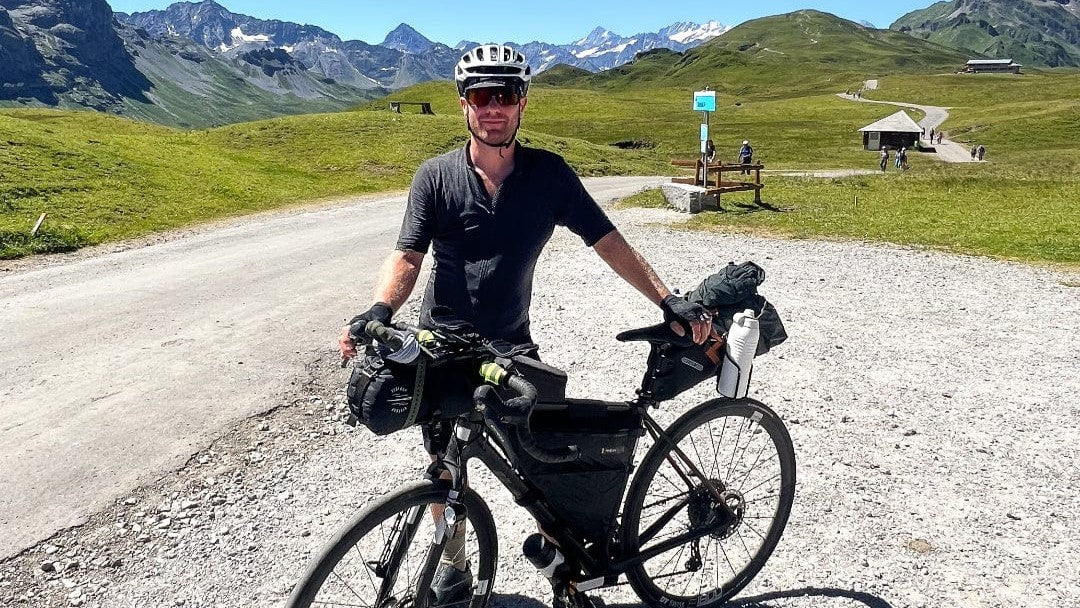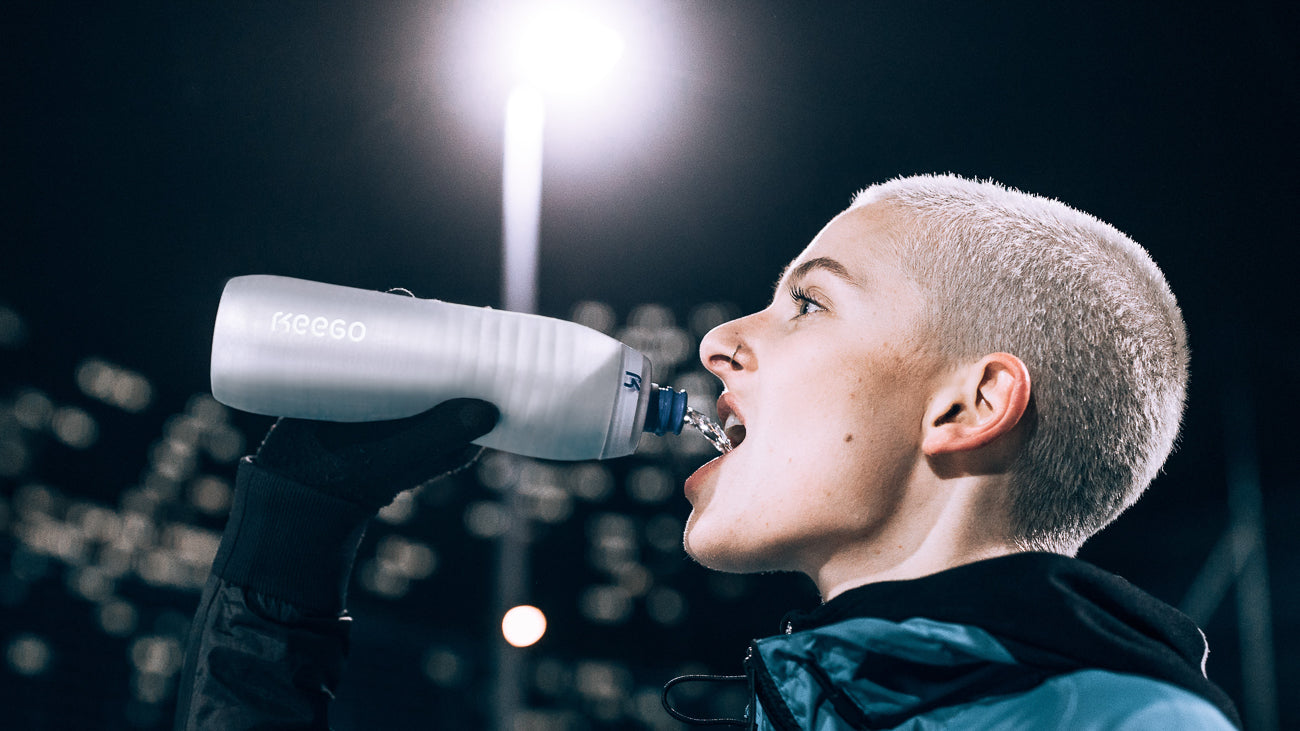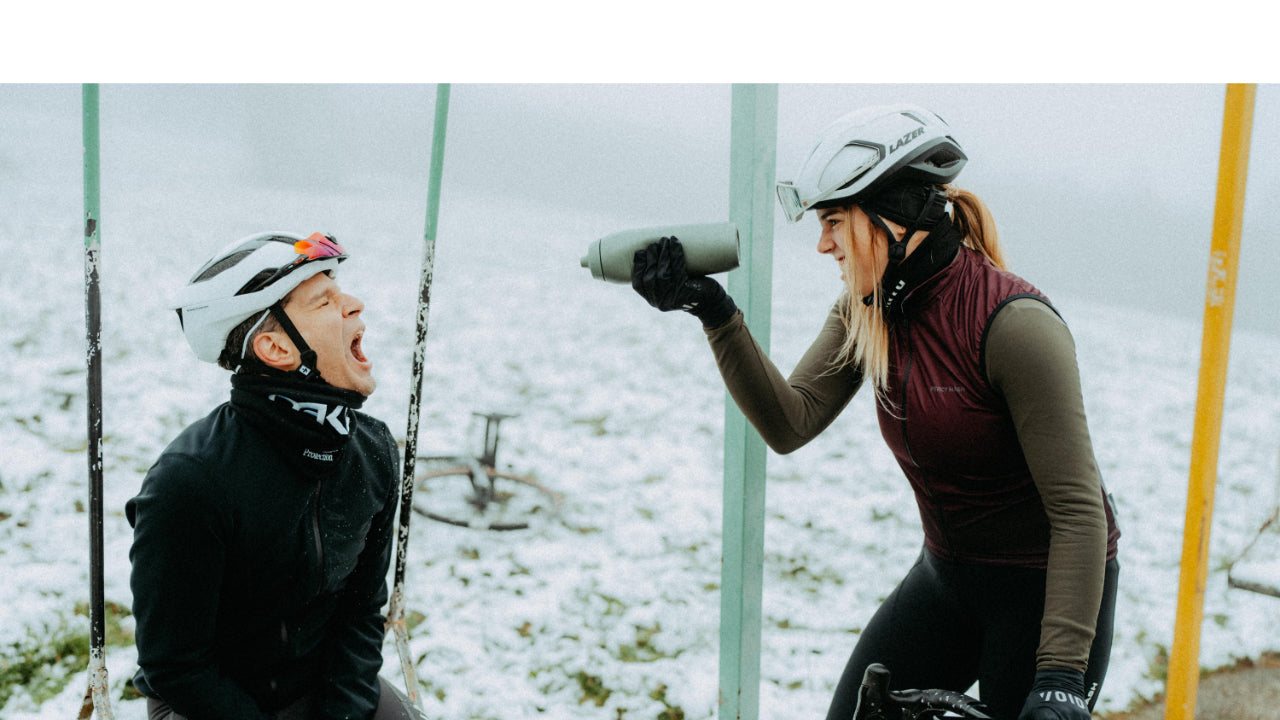Kilometer 121. Semmering Pass summit. Five hours after the start: The water bottle that I received as a gift with the purchase of a vitamin-mineral powder the day before flies into the trash can in front of the supermarket. Fortunately, I still have two other bottles.
But first, let's go back a good month to when I spontaneously cycled past the KEEGO headquarters in Vienna. Loaded with my photo equipment from a shoot, I spontaneously got into conversation with Jana and David and immediately got a product demonstration.
Convinced of the added value of the bottles, I decided to strap two bottles to my bike during my ultracycling race from Vienna to Nice.
Short lunch stop with a jump into the refreshing Lake Walen
The Three Peaks Bike Race is considered an entry-level race in the ultracycling scene and actually deters any reasonable person due to the distance to be covered in the shortest possible time. Approximately two thousand kilometers and thirty thousand meters in altitude must be completed in a maximum of ten days. A good third of the starters don't even reach the finish line. Nevertheless, the ambition and thirst for adventure in me urged me to participate.
Months of preparation, many training rides, and desperate attempts to reduce my luggage more and more to the essentials finally led me to the starting point in front of Schönbrunn Palace.
With a queasy feeling in my stomach, stuffed with potatoes, bananas, and still chewing the last bites of my croissant, I start at a moderate pace towards the west to complete a starting course through the beautiful Vienna Woods that I know well. Radiant summer weather accompanied the good 165 participants starting into the night. My frame bag was well stocked with power gels, a few bars, gummy bears, a piece of cake and a few boiled potatoes. I clamped two Keego water bottles, one filled with mineral powder and one always filled with water, into my bottle holder at the rear end of the saddle and a spare bottle with water was attached to a holder on my fork. The spare bottle was a promotional gift and, as expected (even after thorough pre-cleaning), the water in it took on a disgusting plastic taste within a few minutes. At my first stop at the Semmering, where I got some supplies in the supermarket, I decided to dispose of the bottle. Not an easy decision, because even in a multi-day race, every minute that you unnecessarily spend searching for water, other food or a place to sleep takes its toll.

Checkpoint 2 at the Tannalp high plateau, Melchsee-Frutt
The first few days went very well, apart from some discomfort while sitting. For my very first race ever, I was very happy with my performance. I increased my pace from checkpoint 1 (a course from the Drei Zinnen to the Passo Giao) and reduced the sleep breaks in the following days. The journey continued over the Brenner Pass through the Inn Valley over the Arlberg Pass, past Swiss lakes to Checkpoint 2 in Tannalp, just south of Lucerne, where I spent the night sleeping on the shore of Lake Lucerne.

Overnight stay on the shore of Lake Lucerne near Lucerne
Since the Grimsel Pass and the ride through the entire Rhône Valley did not intimidate me, I decided to cross the Grand Saint Bernard to Italy at night. Almost. Around four o'clock in the morning I had to take a power nap in a randomly found party tent in a hammock. Then I continued via Aosta and the Valsavarenche Valley to get to the key point of my self-planned route. Four hundred meters of altitude carrying passage over a steep path with steps and rock ribs, which then leads over an imposing high plateau to checkpoint 3, to the Colle del Nivolet.

Nivolet reservoirs - “Quickly back down, it's getting cold“
How were the bottles? Wonderful. A little dirty on the outside—I opted for white bottles. But even though I never really washed the bottles, just shook them out and rinsed them with water, I couldn't Taste any musty smell or strange Taste . The most ingenious thing: KEEGO's brand promise of no plastic taste holds true. So far. Five months after I bought the bottles.

I could actually drive on into the night now.
How was I? Terrible. After two days without sleep, I had my first real low and was really very close to giving up the race. After the descent from the summit, I looked for a guesthouse and postponed the decision until the next morning.
Days later, while analyzing my route data, I also found the reason for my slump. I cycled almost 400 km and 8000 meters in altitude from Lucerne to Turin with only one hour of sleep.

Actually totally proud, but close to giving up
After five hours of sleep at the foot of the Nivolet, the world looked different again and I cycled past Turin at a brisk pace over the Col de Montgenèvre to France, treated myself to an evening pizza at a beautiful campsite and decided to cycle through the night again to tackle Mont Ventoux the following morning.
Poor detailed planning unfortunately became my undoing at the foot of Mont Ventoux, as the approach to the mountain led through a gorge where I had to endure a temperature drop of 12 °C about two hours before dawn in a sparsely populated area without gas stations or closed shops. Fortunately, severe hallucinations due to the exertion of the previous days and lack of sleep did not occur, but I still had to deal with concentration problems, as well as the water shortage in the area. This is where the decision to throw away the spare bottle backfired.
In the end, the successful participants, who had now also made it over Mont Ventoux, were rewarded with an intense finisher course. Although it was also challenging in absolute terms, the spectacular view and the beauty of the alpine-maritime area around the Grand Canyon de Verdon made up for the hardships.

Breathtaking panorama of the Verdon Gorge
A few hours before Nice, I decided to spend another night in a hotel. A look at the GPS tracker revealed my position in 49th place, and the positions of the pursuers in the immediate vicinity no longer seemed to be moving. I was sure that I could easily manage the following six to eight hours of driving time to the finish line, but I didn't want to be alone at three o'clock in the morning without a hotel room at the finish line in Nice. I started towards Nice at four o'clock in the morning, satisfied and at a moderate pace, enjoyed the hustle and bustle of the weekly market at one or two main squares over an espresso, and looked forward to the moment when the sea would finally reveal itself.
A few hours later, I finally found myself on the promenade of Nice and saw the checkered flag on my GPS device getting closer.

The last kilometers to the finish. I'm actually in Nice.
The reception at the finish line with celebratory beer and a final photo was relatively unspectacular – but presumably the days before were so intense that the feeling of finally having made it was completely lost in the rush of experiences. And honestly, I never thought I'd get this far and even manage to do it one day before the race ended.

The grin says it all. (Photo: Michael Wacker)
I can give a definite recommendation for the bottles after the race (and also for the time afterwards until today). However, I would no longer take them in white for this intensive use. A few scratches from the bottle cage are probably unavoidable on every bottle, but dirty fingers and road dirt leave their mark on this color under extreme conditions. The bottles have also survived a few impacts on the ground with their contents without any problems so far.
Also highly recommended is the KEEGO Dust Cap, which keeps the mouthpiece clean from dirt, especially in rainy weather.
And by the way: When trying to squirt the water into your mouth for the first time, don't aim directly at the spot where you almost have to throw up.
So much from me.
KEEP GOING
Uwe
Our ambassador and author of the guest article Uwe, when he is not cycling over three mountain peaks, works as a freelance photographer.
If you would like to contact him, you can find more information here: Uwe Strasser



